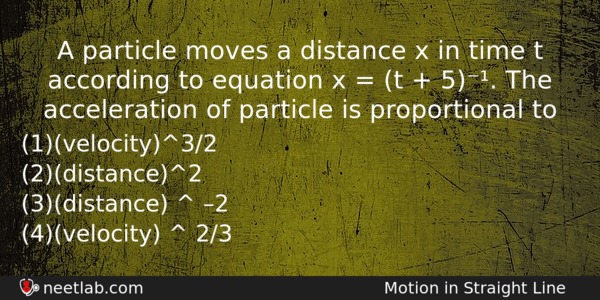| ⇦ | 
| ⇨ |
A particle moves a distance x in time t according to equation x = (t + 5)⁻¹. The acceleration of particle is proportional to
Options
(a) (velocity)^3/2
(b) (distance)^2
(c) (distance) ^ –2
(d) (velocity) ^ 2/3
Correct Answer:
(velocity)^3/2
Explanation:
x = 1 / t + 5
v = dx / dt = -1 / (t + 5)²
a = d²x / dt² = 2 / (t + 5)³ = 2x³
Now, 1 / (t + 5) ∞ v½
1 / (t + 5)³ ∞ v³/² ∞ a
Related Questions: - A thin circular ring of mass M and radius R rotates about an axis through its centre
- A battery having e.m.f. 4 volt and internal resistance 0.5 Ω is connected
- A nuclear reaction is given as 4 ₁H¹→₂He⁴+₀e¹+energy Mention the type of reaction.
- The unit of permitivity of free space, ε₀ is
- A body weighs 50 grams in air and 40 grams in water. How much would it weigh in a liquid
Topics: Motion in Straight Line
(93)
Subject: Physics
(2479)
Important MCQs Based on Medical Entrance Examinations To Improve Your NEET Score
- A thin circular ring of mass M and radius R rotates about an axis through its centre
- A battery having e.m.f. 4 volt and internal resistance 0.5 Ω is connected
- A nuclear reaction is given as 4 ₁H¹→₂He⁴+₀e¹+energy Mention the type of reaction.
- The unit of permitivity of free space, ε₀ is
- A body weighs 50 grams in air and 40 grams in water. How much would it weigh in a liquid
Topics: Motion in Straight Line (93)
Subject: Physics (2479)
Important MCQs Based on Medical Entrance Examinations To Improve Your NEET Score
18000+ students are using NEETLab to improve their score. What about you?
Solve Previous Year MCQs, Mock Tests, Topicwise Practice Tests, Identify Weak Topics, Formula Flash cards and much more is available in NEETLab Android App to improve your NEET score.
Share this page with your friends

Thankyou